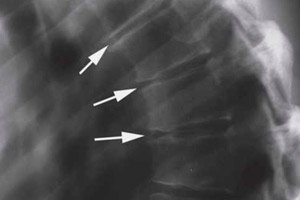
All iLive content is medically reviewed or fact checked to ensure as much factual accuracy as possible.
We have strict sourcing guidelines and only link to reputable media sites, academic research institutions and, whenever possible, medically peer reviewed studies. Note that the numbers in parentheses ([1], [2], etc.) are clickable links to these studies.
If you feel that any of our content is inaccurate, out-of-date, or otherwise questionable, please select it and press Ctrl + Enter.
Scheiermann-Mau osteochondropathy.
Medical expert of the article
Last reviewed: 04.07.2025

Degenerative-dystrophic process in the bones of the spine is osteochondropathy of Scheuermann-Mau. Most often it is diagnosed in childhood and adolescence aged 11-18 years. The disease is characterized by damage to the bodies of the thoracic discs and vertebrae, endplates. Bone destruction occurs in the thoracic spine, and in some cases in its lumbar-thoracic zone.
 [ 1 ]
[ 1 ]
Causes osteochondropathies
The etiology of the disease has not been fully studied, but it has been established that it is affected by heavy physical labor, increased physical stress, injuries, and hormonal imbalance. There are several types of destruction of the vertebral body and discs:
- Kümmel's disease is an inflammation of the vertebral body. It develops after injuries.
- Chondropathic kyphosis is an inflammation of the muscles at the point of attachment to the vertebrae. It occurs with deformation of the vertebrae, due to which they acquire a wedge-shaped form and the thoracic region bends backwards.
- Chondropathy is the destruction of a vertebra, one of the varieties of Calve's disease. The vertebrae expand and decrease in height. A protrusion of the spinous process is observed, and severe pain occurs when palpating it.
The causes of necrosis and destruction of bone tissue are associated with the disruption of its blood supply. The disease also occurs due to the action of such factors:
- Hereditary predisposition.
- Infectious diseases.
- Congenital anomalies of the musculoskeletal system.
- High load on the spine and frequent microtraumas.
- Imbalance of calcium and vitamins, impaired absorption.
- Hormonal disorders.
 [ 2 ]
[ 2 ]
Symptoms osteochondropathies
All types of pathology are characterized by slow development. The main symptoms of the disease include:
- Muscle hypotonia.
- Rapid muscle fatigue.
- Asymmetry of the back muscles.
- Intense pain in the spine.
- Spinal deformity: flat back, deformed shins, funnel chest.
- Difficulty bending the body or head forward.
Diagnostics osteochondropathies
Treatment osteochondropathies
Treatment is conservative. First of all, pain syndrome is relieved and spinal mobility is restored, posture is improved, and osteochondrosis development is prevented. Subsequently, measures are taken to correct posture and restore natural spinal curves. Physiotherapy and exercise therapy are aimed at improving the functions of the vertebrae and discs, and body mobility when bending.
Prevention
For prevention, drugs that modify the structure of cartilage tissue, physiotherapy, therapeutic exercises, multivitamin complexes and iron preparations are used. Surgical treatment is carried out in case of severe fixed kyphosis. For treatment, the method of wedge resection of vertebrae or osteotomy of the spine is used. With timely treatment, the pathology has a favorable prognosis.

